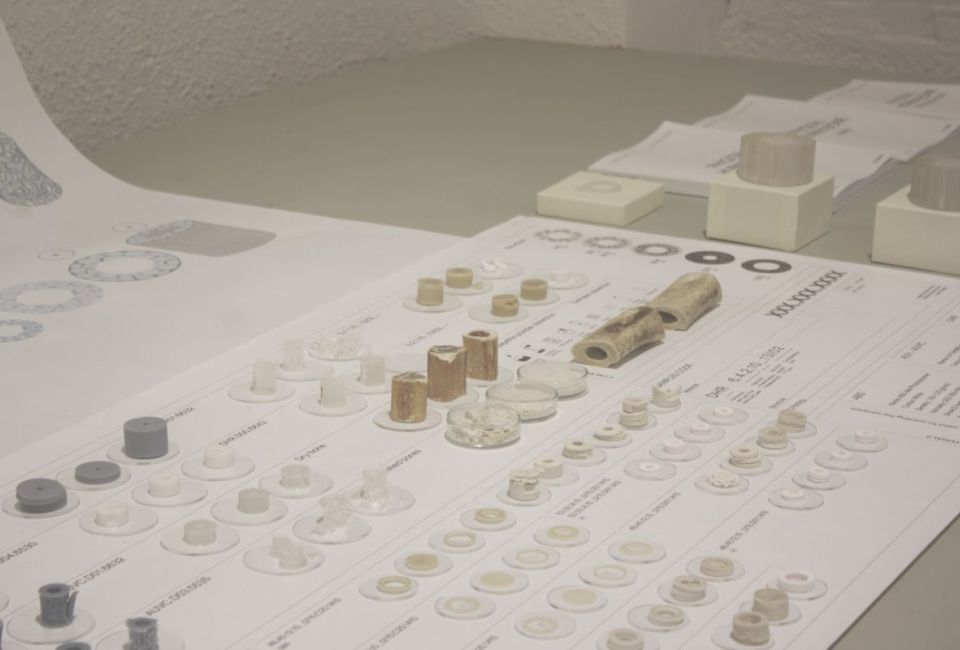
A team of students and researchers at UVic-UCC design 3D printed synthetic human bone as part of the "Phygital Human Bone" project
Five students at the University of Vic - Central University of Catalonia (UVic-UCC) have participated in the "Phygital Human Bone" project undertaken by Elisava and the TR2Lab research group. In addition to the study's objectives and its innovative results, the project is also important because for the first time, it has been carried out on a coordinated basis by students from two of the four campuses of the University of Vic - Central University of Catalonia (UVic-UCC): UElisava and UVic.
"Phygital Human Bone" is a pioneering research project that involves the creation of a phygital (physical and digital) model of synthetic bone which uses an innovative biomimetic design and a 3D bioprinting technique to replicate the properties of the human femur. It aims to replicate its internal microarchitecture in order to synthetically simulate the biomechanical properties of the bone. As a result, fracture patterns can be studied for the first time, although other similar studies in this field have been carried out in the past. The result is a synthetic model that can recreate the properties of a biological tissue (bone tissue).
This recreation achieved by "Phygital Human Bone" is very useful for both controlled trials and biomechanical experimental studies, since it enables a controlled reproduction of human bone, and allows various scenarios to be studied which were previously impossible, due to both ethical and legal issues and availability of material. The results of the project also open up new opportunities for conducting more precise research in the field of medicine and biomechanics.
Multidisciplinary teamwork
Four of the five students who took part are Industrial Design Engineering bachelor's degree students at UElisava - Nim Carbonell, Gerard Estrada, Maria Jesús de Pouplana and Pau Daura, and one, Júlia Guri, is a student on the bachelor's degree in Biotechnology. They all worked together on their respective degree final projects, thereby combining several disciplines in a single project.
The project was carried out in the bone remodelling research area of the Tissue Repair and Regeneration research group (TR2Lab - Tissue Repair and Regeneration Laboratory) at UVic-UCC, and was supervised by Dr Juan Crespo, a researcher and professor at Elisava, and Dr Xavier Jordana, a researcher and professor at the UAB, who are both members of TR2Lab. The academic tutors were professor Marco Gesualdo, for Elisava, and Dr Marta Otero, of UVic, the director of the TR2Lab.
"This collaborative project is a clear example of the TR2Lab's commitment to fostering the scientific vocations of our bachelor's degree students, by involving them in active research projects and undertaking work in multidisciplinary teams to address complex challenges in the field of tissue repair and transformation," says Marta Otero, the coordinator of the TR2Lab.
Greater reliability and accuracy in biomedical studies
"Both the high precision model and the compression tests have given very innovative results, which to the best of our knowledge have not been published or manufactured. That is why they are so important," explains Juan Crespo. "While carrying out the project, we developed a digitised parametric model of human bone using algorithm-aided design (AAD) and we produced it with 3D printers, experimenting with composites developed during the project. This phygital model can be used to study fracture patterns and compare them with other fractures taking place in real human dry and wet bones, and by doing so study the correlation between the two."
"This is only the first step," adds Xavier Jordana, the co-supervisor of the project and a researcher at the TR2Lab. "Important improvements need to be made, such as the type of material used to print the synthetic models, but we have achieved our main goal: recreating the biomechanical behaviour of real human bone in its propagation of microfissures and its resistance to fractures."
According to the participants in the project, using synthetic bone models is essential in fields including biomedicine and forensic medicine in order to be able to perform biomechanical tests and trials, thereby overcoming the difficulties involved in performing these tests on real human bones.
They also point out that the human bones from donors that are commonly used in these tests vary considerably (due to age, sex, state of health, etc.) and using synthetic models would help practitioners and researchers to standardise these parameters and adapt them according to the needs of each study.